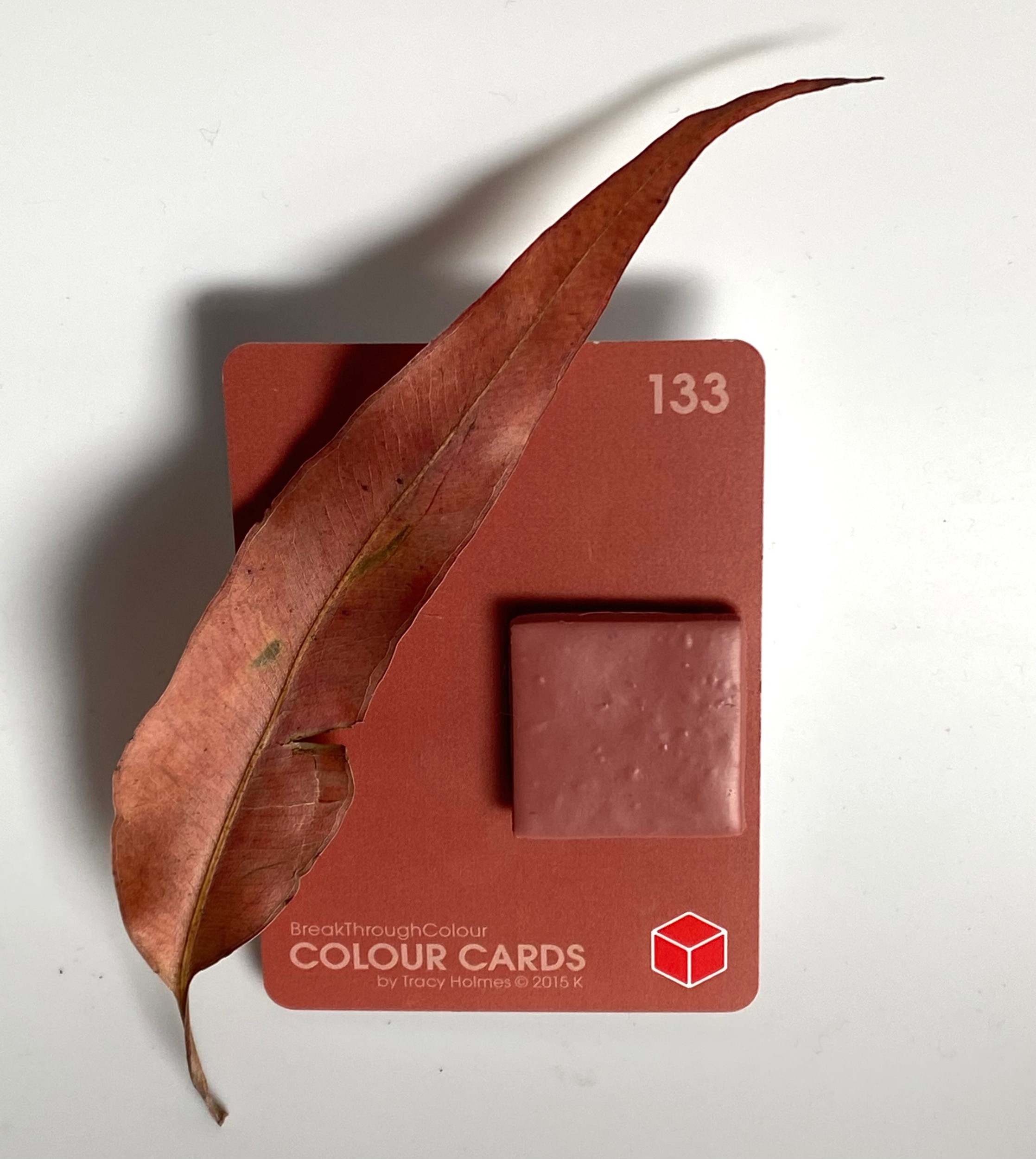A precious endowment

(This post supplements material in Chapter 7 of ‘Connect with Nature’). This image is from the record of an intriguing project undertaken by Wendy Moore, a polymer clay artist of international standing.
What you are looking at is a dead eucalyptus leaf gathered by Wendy on one her bushland walks, a card matching a colour on the leaf, and a polymer clay tile of the same colour.
It is important to understand that the tile is not painted, but painstakingly produced by combining just the right amounts of polymer clay – coloured white, black or one of the three ‘primary’ colours – cyan, magenta, and yellow.
Wendy repeated this process daily for 100 days, committing herself to making the ‘recipe’ for each colour freely available to other artists.
All the colours replicated by Wendy were drawn from nature. What she did was to ‘imitate’ the way the human brain generates the same colours.
Colours as such do not exist in nature. They are created by our brains using information received from cells located in the retinas of our eyes. These cells are of two kinds – rods and cones. The rods are highly sensitive to light and permit us to see at night, but only in shades of grey. The cones, on the other hand, enable us to see colours, but not under conditions of low light. The cones send information to our brain that broadly codes the colours red, green and blue.
Just as Wendy created 100 different colours by combining cyan (bluish-green), magenta (purplish red) and yellow in different ways, our brains ‘create’ a million colours (possibly more) by combining the red, green and blue signals they receives from the cone cells.
Apart from those in people who are colour blind, our brains distinguish several colours, notably red and green, extremely well. This makes us particularly good at detecting and distinguishing ripe and ripening fruit and at foraging more generally. It also helps us with social communication. Many species, including our own, use reddish colours to convey sexual arousal, good health, virility and emotions (blushing when embarrassed, for example).
Only a handful of species share the human ability to colour the world with a red, green and blue palette. Most get by without red. This does not mean that human vision is superior. In some respects, it is but in others, it is outclassed by what the eyes and brains of other creatures can manage.
That said, the ability to distinguish a million different colours is impressive – worthy of wonder in my view. And that is not the only astonishing sensory feat of which we humans are capable.
Perhaps you are familiar with the distinctive earthy and usually pleasant odour that emanates from damp soil that is rich in organic matter – soil on the floor of a rainforest, for example. This is the petrichor smell, which is probably more commonly experienced after a downpour has drenched soil and rock. The word ‘petrichor’ means the essence of rock or the smell of life. It comes from the Greek ‘petros’ – stone, and ‘ichor’ – the vital essence that flows in the veins of the gods. As a primal scent, petrichor directly impacts our minds, affecting mood and evoking memories.
A component of petrichor is geosmin, the usually pleasant odour of soil that is rich in decaying organic matter and bacteria. Geosmin gives root vegetables and carrots their earthy taste. Humans are extremely sensitive to geosmin, detecting it at levels as low as five parts per trillion. It is thought that this sensitivity evolved to support the search for food, especially after periods of drought.
With senses so amazingly attuned to the natural world, it is not surprising that we humans derive so much pleasure from it. One of the most potent sources of our pleasure is the beauty we experience in nature.
Our brains experience beauty because they can detect the forms, patterns and relationships that make an otherwise incomprehensible universe meaningful. They are sensitive to the symmetry, balance, proportion and ratios (especially the Golden Ratio) that are displayed in nature’s more orderly structures such as crystals, water droplets, snowflakes, flowers, seed heads, shells, spiral galaxies, faces, beehives and lava columns. They are also attuned to the ‘fractal’ patterns within the seemingly chaotic complexity of trees, forests, mountain ranges, clouds and coastlines. We humans can find meaning and beauty in what would otherwise be nature’s mind-blowing complexity.
What an amazing ability! We are indebted to the Wendy Moores of this world. Through their nature awareness, creativity and enterprise, they inspire us to cherish, use and benefit from this precious endowment.
This is an example of Wendy’s work.
For more about Wendy and her art, click here.

